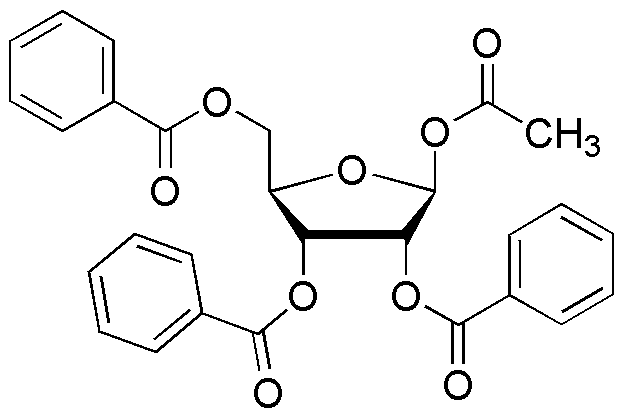1-O-Acetyl-2,3,5-tri-o-benzoyl-b-D-ribofuranose is widely utilized in research focused on:
- Nucleoside Synthesis: This compound serves as a key intermediate in the synthesis of nucleosides, which are essential for the development of antiviral and anticancer drugs.
- Biochemical Studies: It is used in studies involving carbohydrate chemistry, helping researchers understand sugar interactions in biological systems.
- Drug Formulation: The compound's unique structure allows it to be incorporated into drug formulations, enhancing the stability and bioavailability of therapeutic agents.
- Analytical Chemistry: It is employed as a standard in chromatographic techniques, aiding in the analysis of complex mixtures in pharmaceutical research.
- Glycoconjugate Research: This chemical is instrumental in the synthesis of glycoconjugates, which play critical roles in cell signaling and immune response.
Informations générales
Propriétés
Sécurité et réglementation
Applications
1-O-Acetyl-2,3,5-tri-o-benzoyl-b-D-ribofuranose is widely utilized in research focused on:
- Nucleoside Synthesis: This compound serves as a key intermediate in the synthesis of nucleosides, which are essential for the development of antiviral and anticancer drugs.
- Biochemical Studies: It is used in studies involving carbohydrate chemistry, helping researchers understand sugar interactions in biological systems.
- Drug Formulation: The compound's unique structure allows it to be incorporated into drug formulations, enhancing the stability and bioavailability of therapeutic agents.
- Analytical Chemistry: It is employed as a standard in chromatographic techniques, aiding in the analysis of complex mixtures in pharmaceutical research.
- Glycoconjugate Research: This chemical is instrumental in the synthesis of glycoconjugates, which play critical roles in cell signaling and immune response.
Documents
Fiches de données de sécurité (FDS)
La FDS fournit des informations de sécurité complètes sur la manipulation, le stockage et l’élimination du produit.
Spécifications du produit (PS)
Le PS fournit une description complète des propriétés du produit, notamment sa composition chimique, son état physique, sa pureté et les exigences de stockage. Il détaille également les plages de qualité acceptables et les applications prévues du produit.
Certificats d'analyse (COA)
Recherchez des certificats d'analyse (COA) en saisissant le numéro de lot du produit. Les numéros de lot et de lot se trouvent sur l'étiquette d'un produit, après les mots « Lot » ou « Lot de fabrication ».
Numéro de catalogue
Numéro de lot/série
Certificats d'origine (COO)
Ce certificat d'exploitation confirme le pays dans lequel le produit a été fabriqué, et détaille également les matériaux et composants utilisés et s'il est issu de sources naturelles, synthétiques ou autres sources spécifiques. Ce certificat peut être requis pour les douanes, le commerce et la conformité réglementaire.
Numéro de catalogue
Numéro de lot/série
Fiches de données de sécurité (FDS)
La FDS fournit des informations de sécurité complètes sur la manipulation, le stockage et l’élimination du produit.
DownloadSpécifications du produit (PS)
Le PS fournit une description complète des propriétés du produit, notamment sa composition chimique, son état physique, sa pureté et les exigences de stockage. Il détaille également les plages de qualité acceptables et les applications prévues du produit.
DownloadCertificats d'analyse (COA)
Recherchez des certificats d'analyse (COA) en saisissant le numéro de lot du produit. Les numéros de lot et de lot se trouvent sur l'étiquette d'un produit, après les mots « Lot » ou « Lot de fabrication ».
Numéro de catalogue
Numéro de lot/série
Certificats d'origine (COO)
Ce certificat d'exploitation confirme le pays dans lequel le produit a été fabriqué, et détaille également les matériaux et composants utilisés et s'il est issu de sources naturelles, synthétiques ou autres sources spécifiques. Ce certificat peut être requis pour les douanes, le commerce et la conformité réglementaire.


